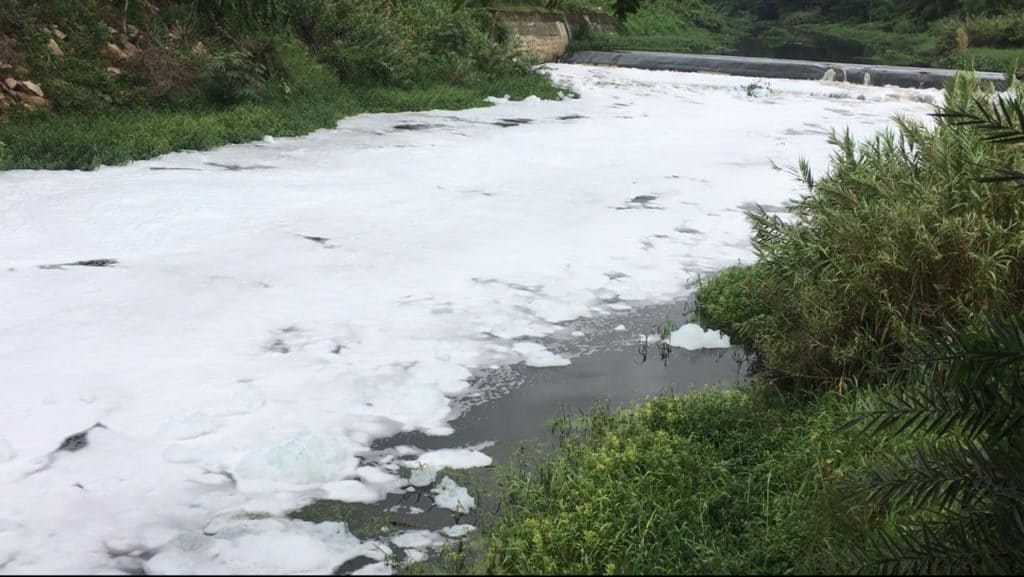This is a time of immense grief and loss for me. Unable to face the harsh reality of my mother gasping for each breath in the ICU, I was drowning myself in work. Coincidentally or so I think, I was working on a report analysing asphyxiation of Vrishabhavathi, Arkavathi, and Cauvery rivers, and suffocation of aquatic lifeforms the rivers supported. As the dissolved oxygen graph took shape, I realised: The million times I had held the dissolved oxygen meter underwater to measure oxygen saturation levels across rivers was no different from the million times we plugged the oximeter to my mother’s forefinger to check for oxygen saturation levels. The realization that the very element my mother was gasping for, is the very element the rivers have long been gasping for – Oxygen and this pushed me deeper into a state of despair.
Waiting in line – in a state of shock and horror – to perform my mother’s last rites at Sumanahalli Crematorium, the familiar smell in the air took me towards the valley. The Vrishabhavathi river flowed dark and foul next to the crematorium. The river was dead, so was my mother. The river was suffocated by an endless assault of man, my mother was suffocated by an endless assault of the virus. As grief seized me at the moment, I was grieving for the river as much as I was for my mother. In a rare moment of clarity, they both seemed to be like the same thing – life-giving forms that died prematurely and needlessly.

Read more: The day it rained ash
While we gently dropped my mother’s ashes into Cauvery, polluting the river, I was unable to brush aside the onslaught of thoughts – both rational and irrational. As I watched Cauvery take my mother away, I imagined my mother stuck behind the dam, quite similar to how Cauvery will be stuck behind the dam – the proposed Mekedatu Hydropower Dam. Holding Cauvery hostage behind the dam will stop the natural flow that is her right. A prisoner for life, she will have to orphan her children- fishes, molluscs, reptiles, insects, plants, mammals – just like my mother orphaned me. Most of these orphaned children will become homeless and eventually die.
Worldwide, the populations of freshwater species dropped by a whopping 83% since 1970s. It is not the death that hurts the most, but the extinction of species itself. Cauvery near Mekedatu is the last ground for many an endangered life-forms – the famed Tiger of Cauvery (Humpback Mahseer), Grizzly Giant Squirrels, Mugger Crocodiles, Smooth-coated Otters, Honey Badgers, Indian Star Tortoise, a long list of vulnerable native fishes, and numerous other life forms known/unknown to man. Lifeforms are currently going extinct tens to hundreds of times faster than the natural background rate. One million of the world’s estimated 8 million species of plants and animals are threatened with extinction.

In this context, it is not an understatement for me to say, the Mekedatu Dam project is an extinction-level infrastructure activity for the Cauvery river ecosystem. Building this dam will be the last nail in the coffin for Cauvery. She will completely cease to exist as a river.
Read more: Thirsty city tantrums: How Bengaluru’s thirst for water is felt 400 km away
Unless a few good citizens, with a little bit of empathy and lots of courage, speak up for — the Rights of Cauvery to flow, Rights of her children to a clean, flowing river, Rights of the Humpback Mahseer to the pool and chutes of Mekedatu it calls home, Rights of Elephants and Tigers to clean drinking water – Cauvery as we know it will become extinct.
Borrowing from Dr Suess’s The Lorax – “I am the Lorax, who speaks for the rivers, which you seem to be damming as much as you please”. The rivers have rights too and we are trespassing. I assert on behalf of Cauvery and the lifeforms she supports, those rights – Sadda Haq Aithe Rak (in Punjabi, literally means ‘give me what’s mine, right here (and right now)’). I hope you can join me too.
[This story was first published on SANDRP. It has been republished with permission. The original article can be found here.]